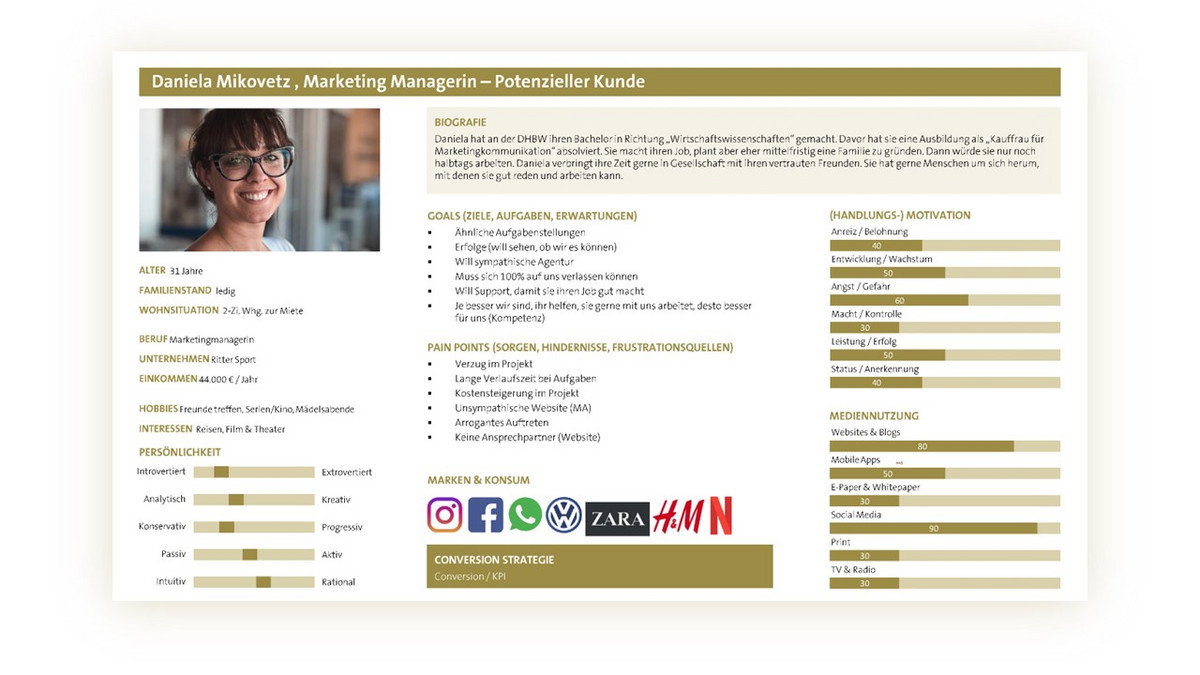Marketing has become digital and therefore much less personal than it used to be. Instead of quickly getting to know our potential customers face to face, they often go through the majority of their customer journey alone. To ensure that this still suits them, we use so-called personas in both UX and lead management.
What is a (buyer) persona?
The target group is the traditional approach in marketing. It comprises a broad interest group that shares certain characteristics:
- Socio-demographic data (age, gender, marital status, occupation, income)
- Media usage (channels, devices)
- Psychological models
- Generic target groups (new customers, existing customers, potential applicants)
This approach is quite generic. A persona, a fictional character that personifies the target group, is therefore used to try and define these people more precisely. In addition to the characteristics mentioned above, others are also considered:
- Goals (objectives, needs, expectations)
- Pain points (worries, obstacles)
- Interests
- Behavior (motivation, drive)
- Characteristics (personality)
With a buyer persona, the persona is expanded to include information about their day-to-day work and the customer journey:
- Purchase criteria (information behavior, purchasing behavior, customer journey)
- Everyday working life (decision-making processes, communication channels)
- Product (expectations, wishes, rejection)
Why are (buyer) personas so important?
"Male, born in the 60s, has children, known worldwide, US-American, successful". If you only define your target group by these values, you have put Barack Obama and Jon Bon Jovi in one target group.
Another example: With the criteria "Female, born in the 1950s, has no children, well-known in Germany, successful", you are simultaneously addressing Angela Merkel and Hella von Sinnen. This can fit by chance, but can also go very wrong.
Buyer personas help to determine more precisely who we want to reach.
How do you create a (buyer) persona?
The target group analysis should serve as the basis for developing a buyer persona. Market research or customer data, for example, is suitable for this. This data is then analyzed to identify patterns or trends. Based on these findings and with the help of different perspectives (e.g. marketing, sales, service, product development ...), a persona is developed in a workshop that reflects the typical characteristics, needs and behavioral patterns.
To make this persona tangible, a character profile is often created that contains all the important information. The more compact the data is presented, the easier it is to work with.
How are personas used in UX?
Users decide within milliseconds whether they like something or not. If they don't feel they have been well catered for on a website, they close it again immediately and look for a website that suits them instead.
Personas are therefore used for various areas and tasks of UX:
- Strategy: Does the strategic direction of the brand or product match the persona?
- Content: Does the type of communication, tonality and imagery match the persona?
- Design: Do the design, style, colors and imagery match the persona?
- Personalization: What preferences and interests can be used to create
personalized pages?
- UX testing: Is the website tailored to the needs of the persona?
Personas are not only used to create websites, however. They also help to provide employees with a consistent image of customers or to plan and produce suitable content.
How are personas used in lead management?
The use of personas in lead management partly overlaps with their use in UX. Here, too, they help to gain a uniform picture of customers, create suitable content and build websites correctly. A uniform customer image enables marketing and sales to move more consistently in the same direction.
Buyer personas are the basis for successful lead management. The customer journey, good content and suitable marketing measures can only be created if you know exactly who you want to address and what questions or problems these people have.
Buyer personas for the customer journey
The customer journey is divided into three phases up to the point of purchase: Awareness, Consideration, Purchase. In each of these phases, potential customers ask questions that we can only answer with marketing measures and suitable content if we know them precisely.
It is also important to know the preferences of the buyer persona when selecting the right formats and channels. Do they prefer to read white papers or watch short videos? Are they more likely to be on LinkedIn or TikTok? If we use the wrong format or the wrong channel, we simply won't reach our buyer personas.





